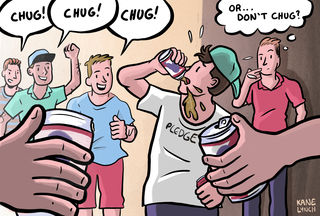Sport and Competition
Hazing: When Rites of Passage Are Harmful Practices
Research sheds light on college student hazing and how to reduce its harms.
Posted September 30, 2019
It was the start of the academic year and the beginning of hazing season. The fraternity pledges did knuckle push-ups and endured late-night ocean “dunking” that made them feel like they were drowning. The sorority pledges were humiliated as members critiqued their appearances and circled the fat on their bodies with Sharpies. The track team compelled new underage members into drinking, forced exercising, and a scavenger hunt that included sexually explicit items. New marching band members were expected to walk the length of a parked, dark bus as senior band members beat them along the way. In all cases, there was the understanding that this, along with silence, was the price of admission for new or aspiring group members.
Student fraternities and sororities, varsity athletics, club sports, intramural sports, performing arts organizations, faith-based organizations, and academic clubs, sometimes have norms where members, or potential members, are expected to show their commitment by being subjected to or participating in embarrassing, abusive, exploitative, and/or dangerous activities. Regardless of whether a student willingly chooses to participate, these activities are known as hazing.

A recent study (Allan et al., 2019) of over 5,000 American college students from seven universities “with a demonstrated commitment to hazing prevention,” found 26% of students reported at least one experience that met the definition of hazing (prior studies of colleges found rates of 55%). Rates were higher for students on varsity athletic teams (42.7%), fraternities and sororities (38.3%), and club sports (28.5%). The most common were hazing behaviors involving excess drinking, social isolation, personal servitude, and humiliation.
In some groups, hazing is about reinforcing the power and status hierarchies that allow senior members to dominate new members. Hazing is also a way for prospective members to prove their commitment to a group or organization, while simultaneously increasing those new members’ commitment. When people freely choose to undergo a difficult initiation, it often increases their commitment. They need to believe the membership price was worth it; otherwise, they’re fools for choosing to endure it, and for choosing a group that would do that to them. Perhaps this is why Allan et al. (2019) found hazed students reported positive outcomes to being hazed such as feeling more a part of a team or group (62.8%); feeling a sense of accomplishment (54%), and feeling stronger (35.7%). Maybe they needed to justify their efforts.
But in the Allen study, 48 percent of hazed students also reported feeling stressed, depressed, humiliated, and degraded by hazing. Almost 30 percent reported hazing-related academic problems or sleep difficulties. And don’t forget, some students die to belong; there’s at least one college student hazing death every year (see my blogs on Carson Starkey and Timothy Piazza for examples).
As you might expect, colleges and universities have responded by enacting anti-hazing policies and 44 states have laws making hazing illegal. But hazing persists despite such policies.
Given the secrecy surrounding hazing, it’s students that have the most power to stop hazing or reduce its harms. They need to act when a group’s practices put new or prospective members at risk for physical or emotional harm and when hazing traditions place the group and its leadership at risk for criminal or university penalties. We need to motivate students to act even when high-status group members are unconcerned when the group has strong norms of secrecy and protection, and when acting carries social risks such as loss of status, shunning, or rejection.
We need to develop students’ bystander intervention skills so that they will say or do something when a group or organization’s “membership tests” cross the line. This requires increasing students’ awareness of hazing-related risks and costs and correcting hazing myths such as the idea that hazing builds group cohesion and bonding. (Studies find hazing actually undermines relationships between teammates and peers, and most hazed students don’t believe it’s effective or necessary to create bonding.)
We need to help students understand how hazing (which is abusive, dangerous, degrading, or exploitative) differs from rituals and initiations that promote commitment and group cohesion without putting prospective members in harm’s way. Coaches, student affairs professionals, national Greek organizations, etc. should also encourage student leaders to review their traditions around the initiation of new and prospective members, discard or remake those traditions that meet the definition of hazing or are otherwise high-risk, and develop non-harmful alternatives that provide the benefits intended by hazing.
Finally, we need to approach hazing from a harm-reduction perspective. Most hazing deaths, for example, involve alcohol poisoning. While it’s probably unrealistic to expect students to stop drinking to excess, we can help them identify the signs of alcohol poisoning and build their intervention skills. We can also reduce some of the perceived costs of getting help with medical amnesty policies and laws (MAPs). MAPs protect students and sometimes student organizations from formal university disciplinary action or criminal prosecution when they call for help for an alcohol or drug related emergency.
References
Allan, E. J., Kerschner, D., & Payne, J. M. (2019). College student hazing experiences, attitudes, and perceptions: Implications for Prevention. Journal of Student Affairs Research and Practice, 56, 32-48.
Allan, E. J., & Madden, M. (2012). The nature and extent of college student hazing. International Journal of Adolescent Medicine and Health, 24, 83-90.
Allan, E. J., Payne, J. M., & Kerschner, D. (2018). Transforming the culture of Hazing: A research-based hazing prevention framework. Journal of Student Affairs Research and Practice, 55, 412-425.
Aronson, E., & Mills, J. (1958). The effect of severity of initiation on liking for a group. Journal of Abnormal and Social Psychology, 59, 177-182.
Bloom, J. L., & Cuevas, A. E. P. (2018). An Appreciative Approach to Hazing Prevention. In Critical Perspectives on Hazing in Colleges and Universities (pp. 126-136). Routledge.
Cimino, A. (2011). The evolution of hazing: Motivational mechanisms and the abuse of newcomers. Journal of Cognition and Culture, 11, 241-267.
Haas, A. L., Wickham, R. E., McKenna, K., Morimoto, E., & Brown, L. M. (2018). Evaluating the effectiveness of a medical amnesty policy change on college students’ alcohol consumption, physiological consequences, and helping Behaviors. Journal of Studies on Alcohol and Drugs, 79, 523-531.
Nuwer, H. (Ed.). (2018). Hazing: Destroying young lives. Indiana University Press.


